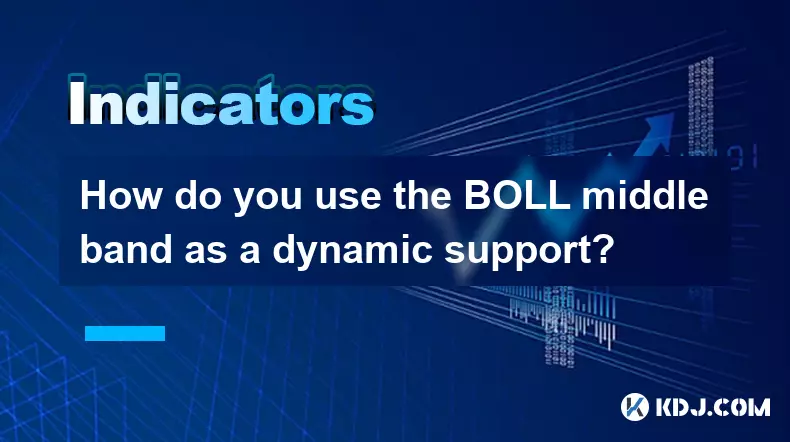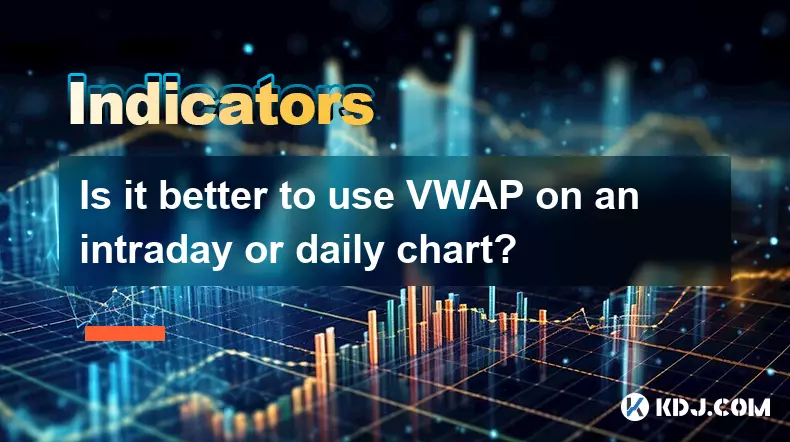-
 bitcoin
bitcoin $108842.957301 USD
-1.88% -
 ethereum
ethereum $3931.777121 USD
-1.66% -
 tether
tether $1.000186 USD
-0.03% -
 bnb
bnb $1153.250882 USD
-2.20% -
 xrp
xrp $2.367904 USD
-1.94% -
 solana
solana $186.182050 USD
-4.20% -
 usd-coin
usd-coin $0.999997 USD
0.00% -
 tron
tron $0.316949 USD
-1.00% -
 dogecoin
dogecoin $0.190780 USD
-3.12% -
 cardano
cardano $0.651324 USD
-2.67% -
 hyperliquid
hyperliquid $37.141055 USD
-0.85% -
 ethena-usde
ethena-usde $0.999224 USD
-0.09% -
 chainlink
chainlink $17.579031 USD
-2.47% -
 bitcoin-cash
bitcoin-cash $509.426284 USD
-2.79% -
 stellar
stellar $0.315298 USD
-2.93%
How do you use the BOLL middle band as a dynamic support?
The Bollinger Bands middle band, a 20-period SMA, serves as dynamic support in uptrends and is most reliable when confirmed by volume, candlestick patterns, and higher-timeframe trends.
Oct 14, 2025 at 05:36 am

Understanding the Bollinger Bands Middle Band
1. The middle band of the Bollinger Bands (BOLL) is a 20-period simple moving average (SMA), which reflects the average price movement over the past 20 intervals. This band acts as a baseline for identifying trends and potential reversals in cryptocurrency markets. Traders rely on its smoothing effect to filter out market noise and focus on meaningful price shifts.
2. In trending markets, especially during bullish phases, the middle band frequently serves as a dynamic support level. When prices pull back toward this SMA after an upward move, they often find temporary stability before resuming their ascent. This behavior becomes more reliable when confirmed by volume patterns and candlestick formations near the band.
3. The strength of the middle band as support increases when it aligns with prior swing lows or confluence zones from other indicators such as Fibonacci retracement levels. Such alignment enhances trader confidence that the area holds significance, leading to increased buying activity when price approaches it.
4. It's essential to monitor how price interacts with the middle band—clean bounces suggest strong trend continuation, while repeated violations may signal weakening momentum. Observing whether candles close above or below the band provides insight into whether bulls maintain control.
Applying the Middle Band in Live Trading
1. To use the BOLL middle band effectively, traders should first identify a clear uptrend by assessing higher highs and higher lows. Once established, any downward correction that touches or slightly dips below the middle band can be watched closely for reversal signals like bullish engulfing patterns or hammer candles.
2. Entry points are often placed just above the low of the reversal candle near the middle band, with stop-loss orders set beneath the recent swing low or slightly under the band itself. This setup allows for favorable risk-to-reward ratios when the trend resumes.
3. Confirmation tools such as RSI holding above 50 or MACD showing positive histogram expansion add credibility to the bounce off the middle band. These complementary indicators help reduce false signals caused by volatile crypto price swings.
4. Scalpers and day traders may use shorter timeframes like 15-minute or hourly charts to exploit these bounces, while swing traders prefer daily charts for stronger, longer-lasting reactions. Adjusting position size according to timeframe volatility ensures better capital preservation.
Recognizing Failure Scenarios
1. Not every touch of the middle band results in a successful bounce. In choppy or range-bound markets, the SMA loses its effectiveness as a dynamic support due to lack of directional bias. Prices may oscillate across the band multiple times without commitment.
2. A decisive close below the middle band, especially on high volume, suggests potential trend exhaustion or reversal. This scenario demands caution—what was once support could transform into resistance if selling pressure persists.
3. During major news events or macroeconomic shocks affecting the crypto space, technical structures including BOLL bands can break down temporarily. Algorithms and large market participants may trigger stop hunts that invalidate typical support logic.
4. Overreliance on the middle band without context leads to poor decision-making. Combining it with structural analysis—like trendlines, order book depth, or on-chain metrics—provides a more robust framework for navigating unpredictable digital asset markets.
Traders who integrate the BOLL middle band with volume analysis and multi-timeframe confirmation significantly improve their odds of catching valid bounces in trending crypto assets.
Frequently Asked Questions
What timeframes work best for using the BOLL middle band as support?The daily and 4-hour charts offer the most reliable signals because they filter out short-term noise common in lower timeframes. These durations allow clearer identification of sustained trends where the middle band functions optimally as dynamic support.
Can the BOLL middle band act as resistance too?Yes, in downtrends, the 20-period SMA often becomes dynamic resistance. Price rallies toward the band may stall or reverse, especially if accompanied by bearish candle patterns and increasing volume, indicating renewed selling interest.
How does volatility affect the reliability of the middle band?High volatility can cause erratic price action around the band, reducing its predictive power. However, during periods of moderate and consistent volatility, the band performs well as a reference point for mean reversion strategies within trending environments.
Is the BOLL middle band effective across all cryptocurrencies?Its effectiveness varies based on liquidity and trading volume. Major coins like Bitcoin and Ethereum exhibit stronger adherence to technical levels due to deeper markets, whereas low-cap altcoins may disregard the band frequently due to manipulation and thin order books.
Disclaimer:info@kdj.com
The information provided is not trading advice. kdj.com does not assume any responsibility for any investments made based on the information provided in this article. Cryptocurrencies are highly volatile and it is highly recommended that you invest with caution after thorough research!
If you believe that the content used on this website infringes your copyright, please contact us immediately (info@kdj.com) and we will delete it promptly.
- Solana, Dogecoin, and the Crypto Dip: Bargain Hunting or Dodging Bullets?
- 2025-10-17 10:45:16
- Gold, Bitcoin, and Investment: Navigating the Digital Frontier in Style
- 2025-10-17 10:25:15
- Bengals vs. Steelers: Live Updates, Week 7 - Who Dey or Black & Gold?
- 2025-10-17 10:25:15
- Dogecoin, Thumzup, and DOGE Rewards: Will Real-World Utility Spark a Rebound?
- 2025-10-17 10:45:16
- BullZilla, Cryptos, Buy October: Navigating the Crypto Jungle in Style
- 2025-10-17 10:50:01
- Cardano, TRON, and MAGACOIN: Navigating the Crypto Landscape in 2025
- 2025-10-17 08:45:15
Related knowledge

What's the main difference between VWAP and TWAP?
Oct 12,2025 at 11:54am
Understanding VWAP and Its Role in Crypto Trading1. Volume Weighted Average Price (VWAP) is a trading benchmark that calculates the average price of a...

How do you identify exhaustion moves using VWAP and its bands?
Oct 12,2025 at 08:00am
Understanding the Role of Decentralized Exchanges in Crypto Trading1. Decentralized exchanges (DEXs) operate without a central authority, allowing use...

Is it better to use VWAP on an intraday or daily chart?
Oct 15,2025 at 02:01am
Intraday Trading and the Role of VWAP1. Intraday traders frequently rely on VWAP (Volume Weighted Average Price) as a dynamic benchmark for assessing ...

How do you use VWAP to scale in and out of positions?
Oct 14,2025 at 02:19am
Understanding VWAP as a Dynamic Benchmark1. The Volume Weighted Average Price (VWAP) is not just an indicator—it functions as a dynamic benchmark that...

What are the main advantages of using VWAP over EMA?
Oct 11,2025 at 02:18am
Main Advantages of Using VWAP Over EMA1. Volume-Weighted Average Price (VWAP) incorporates trading volume into its calculation, offering a more accura...

How do you use VWAP on different chart types like Heikin Ashi?
Oct 11,2025 at 05:01pm
Understanding VWAP in the Context of Heikin Ashi Charts1. The Volume Weighted Average Price (VWAP) is a powerful analytical tool commonly used by trad...

What's the main difference between VWAP and TWAP?
Oct 12,2025 at 11:54am
Understanding VWAP and Its Role in Crypto Trading1. Volume Weighted Average Price (VWAP) is a trading benchmark that calculates the average price of a...

How do you identify exhaustion moves using VWAP and its bands?
Oct 12,2025 at 08:00am
Understanding the Role of Decentralized Exchanges in Crypto Trading1. Decentralized exchanges (DEXs) operate without a central authority, allowing use...

Is it better to use VWAP on an intraday or daily chart?
Oct 15,2025 at 02:01am
Intraday Trading and the Role of VWAP1. Intraday traders frequently rely on VWAP (Volume Weighted Average Price) as a dynamic benchmark for assessing ...

How do you use VWAP to scale in and out of positions?
Oct 14,2025 at 02:19am
Understanding VWAP as a Dynamic Benchmark1. The Volume Weighted Average Price (VWAP) is not just an indicator—it functions as a dynamic benchmark that...

What are the main advantages of using VWAP over EMA?
Oct 11,2025 at 02:18am
Main Advantages of Using VWAP Over EMA1. Volume-Weighted Average Price (VWAP) incorporates trading volume into its calculation, offering a more accura...

How do you use VWAP on different chart types like Heikin Ashi?
Oct 11,2025 at 05:01pm
Understanding VWAP in the Context of Heikin Ashi Charts1. The Volume Weighted Average Price (VWAP) is a powerful analytical tool commonly used by trad...
See all articles










































































